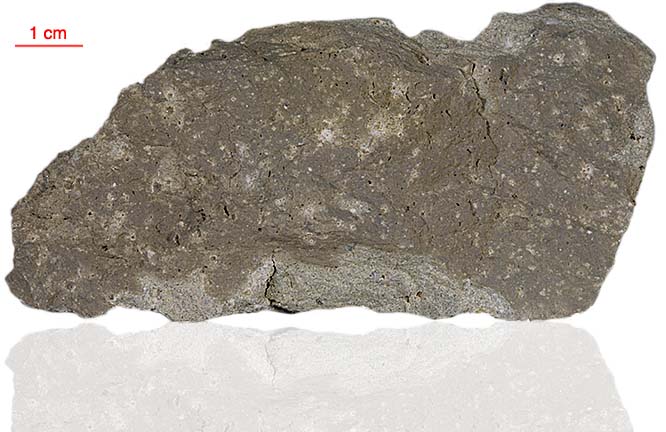
Fact sheet
72315 was thought to be an anorthositic clast (light-coloured patch) in the host rock. However, the sample turned out to be mostly an impact melt breccia – same as the other samples collected from this location (see 72395). It contains abundant mineral clasts, but only minor recognizable clasts of granulitic anorthosite or norite. It is a vesicular impact melt with a characteristic micro-poikilitic texture. It is about 80 % matrix with about 15 % mineral clasts and ~5 % annealed lithic clasts. It also has about 3 % pore space as small irregular vugs. The crystalline matrix of 72315 is composed of interlocking grains of plagioclase, pyroxene and olivine with small, poorly-developed poikilitic pyroxene and ilmenite enclosing laths of plagioclase and rounded inclusions of olivine. Plagioclase in 72315 often has undulatory extinction, and is sometimes feathery (maskelynite devitrification). Apatite, armalcolite and metallic iron with a meteoritic origin are the accessory species. An assortment of mineral clasts are shown in rotations 1 and 2.
The sample weighed 131.4 grams before analysis and has not been dated.
A transcript of the dialogue between astronauts Eugene A. (Gene) Cernan (CDR) and Harrison P. (Jack) Schmitt (LMP) as they sampled this boulder is available on the Lunar and Planetary Institute site.
Further details of this and other Apollo samples are here: http://curator.jsc.nasa.gov/lunar/
Apollo 17, the final manned landing mission, had two objectives: to obtain samples of ancient rocks from the lunar highlands and to look for evidence of younger volcanic activity on the valley floor.
This small Collection contains material deriving from both periods, including igneous rocks around 4.3 billion years old from the lunar highlands as well as younger volcanic samples dating from about 3.6 billion years ago.
Apollo 17 was launched on 7 December 1972.






